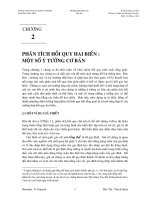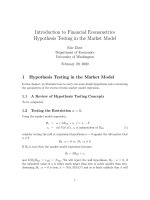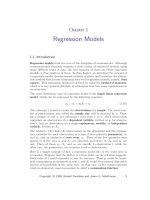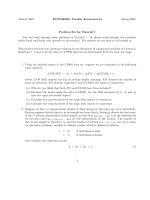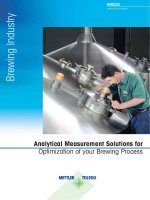Econometrics Solution
Bạn đang xem bản rút gọn của tài liệu. Xem và tải ngay bản đầy đủ của tài liệu tại đây (1.8 MB, 4 trang )
Tran Nguyen Gia Huynh
K55CLC3 - 1601015181
Average value of prpblck 0.113486 – SD: 0.182416 - proportion of black people in New Jersey and
Pennsylvania in percentages
Average value of income 47053.78 – SD: 13179.29 - income is measured in dollars
Psoda = 0.95632 + 0.114988*prpblck + 1.6E-06*income
n= 401, R - SQUARED= 0.06422
The coefficient on prpblckindicates that price of soda increases by 0.115 dollars, or about 11.5 cents,
when the proportion of black people in the community increases from zero (no black people) to one (all
black people).
Psoda = 1.037399 + 0.064927*prpblck
n= 401, R - SQUARED= 0.018076
The discrimination effect is estimated to be significantly smaller when income is excluded
from the regression. (0.064927 vs. 0.114988)
Log(Psoda) = -0.045678 + 0.111118*prpblck + 1.56E-06*income
n= 401, R - SQUARED= 0.066081
If prpblck increases by 0.20, then the price of soda is predicted to increase by 0.111118*0.2 = 2.22%
Log(Psoda) = -0.072912 + 0.086163*prpblck + 1.97E-06*income + 0.15052*prppov
n= 401 R - SQUARED= 0.070581
The coefficient of prpblck decreases from 0.111118 to 0.086163
Given the results of the above regressions (and intuition), I expected a negative correlation. I do not have
enough intuition to expect a particular magnitude of the correlation (although I was not surprised to see
a large correlation between the two). When I found the correlation using Stata’s correlate function, I get:
-0.838467
My concise evaluation: this statement is nonsense. They can certainly be in the same regression. Their
simultaneous inclusion, however, makes it more difficult to identify the independent effects of each on
the price of soda. This does NOT mean that it is illegitimate to include both in a regression.
